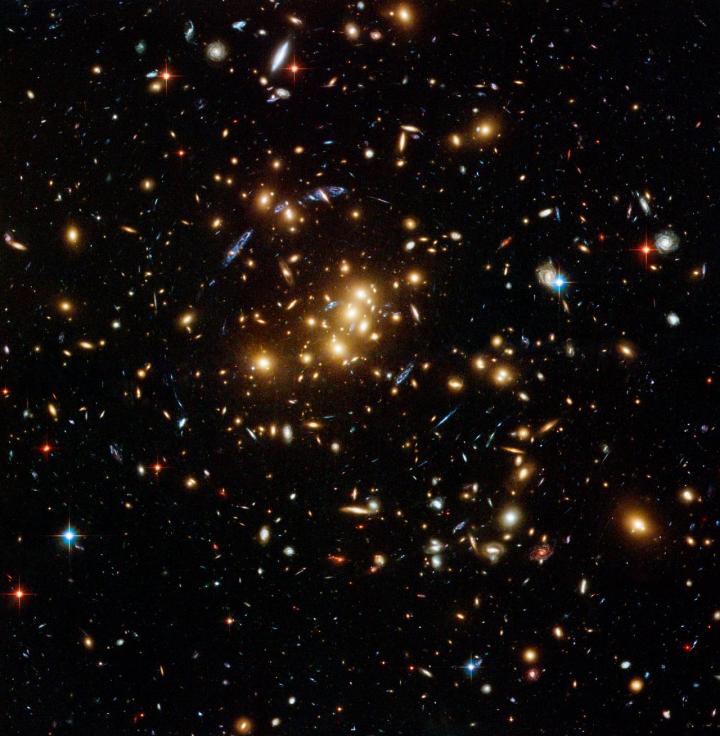ACADEMIA
CU's Burns explains mystery of 'banging' galaxy clusters

Galaxy cluster collision heats gas to 300 million degrees F, more than 10 times hotter than the core of the sun
Two galaxy clusters in the process of merging created a layer of surprisingly hot gas between them that University of Colorado Boulder astronomers believe is from turbulence caused by banging into each other at supersonic speeds.
The two clusters, which are coming together to create the larger galaxy cluster Abell 115, are located some 2.4 billion light years away. The turbulent area of hot gas sandwiched between the two clusters, which CU Boulder Professor Jack Burns likened to a wake behind a motorboat, is about 300 million degrees F. That is roughly three times as hot as the two smaller cluster cores and 10 times hotter than the core of the sun, said Burns, lead study author.
"We did not expect to see such very hot gas between the cluster components," said Burns. "We think the turbulence is like a big spoon stirring up gases, converting the energy of motion from the merging clusters into thermal energy. It is a manifestation of them banging together like two giant pots, something we have not really seen before."
Burns presented the new findings in a press briefing on Tuesday, June 6 at the 230th Meeting of the American Astronomical Society being held in Austin, Texas, June 4-8.
The two merging galaxy clusters individually consist of hundreds of galaxies, each as large or larger than our own Milky Way galaxy, said Burns of CU Boulder's Center for Astrophysics and Space Astronomy. Individual galaxy clusters, which can include thousands of galaxies, are the largest gravitationally bound objects in the universe.
"Energetically speaking, galaxy cluster merging events are the biggest bangs in the universe since the Big Bang," said Burns. "These are massive, very dynamic systems that continue to evolve to this day."
The observations by the CU Boulder team were made using data from NASA's orbiting Chandra X-ray Observatory and the Karl G. Jansky Very Large Array, a radio- astronomy facility near Socorro, New Mexico, operated by the National Radio Astronomy Observatory and funded by the National Science Foundation.
The team's supercomputer simulations show regions of relatively cool gas near the cores of each merging cluster, indicating the two objects have encountered each other before - perhaps circling a few times and stripping gas from one another before merging.
The study co-authors, all from CASA, include Research Associate Eric Hallman, doctoral student Brian Alden, NASA Senior Postdoctoral Fellow David Rapetti and senior collaborator Abhirup Datta. The new study was funded by NASA's Astrophysical Data Analysis Program.
To analyze temperatures within Abell 115 and other similar merging clusters, Burns and his team developed software to produce high-contrast temperature maps of all cluster regions in both the X-ray and radio portions of the electromagnetic spectrum. The new data pipeline uses the NASA Ames Research Center supercomputer to calculate 10,000 to 100,000 spectra in each cluster, said Burns.
The team is continuing to investigate the radio emissions stretching far outside Abell 115 into the intergalactic medium, including their relationship to the hot X-ray gas.
"These radio emissions are caused by electrons in the magnetic field of the galaxy cluster traveling at near the speed of light," said Burns. "Clearly something has energized the electrons, which we think is related to the cluster banging process."
As part of the project, the CU Boulder team is studying a sample of 50 other galaxy clusters for comparison, said Burns.
What's next for Abell 115? "Our supercomputer simulations show these cluster mergers can be really complicated in terms of the accretion process, depending on the state we catch them in," said Burns. "We believe Abell 115 will eventually 'relax' and become centrally condensed, which is relatively boring compared to what we are seeing now."
Galaxy clusters form in what is known as the universe's cosmic web, said Burns. The cosmic web consists of long, narrow filaments of galaxies and intergalactic gas separated by enormous voids. Astronomers believe single cosmic web filaments can stretch for hundreds of millions of light years, an astonishing length considering a single light-year is about 5.9 trillion miles.
